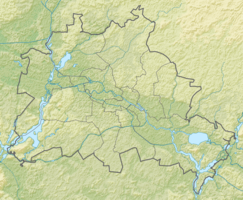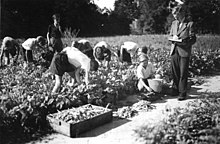Botanical Volkspark Blankenfelde-Pankow
| Botanical Volkspark Blankenfelde-Pankow | ||
|---|---|---|
| Park in Berlin | ||

|
||
| View of the tall greenhouses with connectors in the Botanical Volkspark Blankenfelde-Pankow, April 2015 | ||
| Basic data | ||
| place | Berlin | |
| District | Blankenfelde | |
| Created | 1909 | |
| Newly designed | 1977 redesign and expansion, further redesign from 1994 |
|
| use | ||
| User groups | Pedestrians, cyclists, leisure | |
| Park design | Albert Brodersen | |
| Technical specifications | ||
| Parking area | 323,126 m² | |
|
52 ° 36 '17 " N , 13 ° 23' 43" E
|
||
Botanical Volkspark Blankenfelde-Pankow (historical names: Städtischer Schulgarten Blankenfelde [1949], agro-biological central station of the Thälmann pioneers " Walter Ulbricht " [1953]) is a public park in the Berlin district of Blankenfelde . It houses around 6000 plant species as well as the Geological Wall, a geological show wall, which shows the rock layers of the uppermost crust of Central Europe with 150 types of rock . The park emerged from a school garden , has been open to the public since 1995 and is a listed building .
history
The plant was laid out in 1909 at the suggestion of the horticultural director Albert Brodersen on a disused sewage field as a central Berlin school garden in today's size. As a sewage area, the property belonged to the city of Berlin, the ice age landscape offered the opportunity for a varied design: in the western part, the landscape was largely left with the inclusion of the Zinger ponds, in the eastern part near the main entrance agricultural areas were set up on the grid of the sewage fields. Apple trees were planted on the outskirts and ornamental trees along the main paths. Schools in Berlin were supplied with plant material for botany and drawing lessons. In 1911 an oak and hornbeam forest was created and in 1912 the geological wall was moved here from the Humboldthain park.
In the two world wars 1914–1918 and 1939–1945 , the area served to supply the population with agricultural products. After 1945, at the suggestion of the head of the green planning office Reinhold Lingner, the botanical complex was preserved and restored. In 1952 it became the central station for the young naturalists “Walter Ulbricht”, and the game reserve, aviaries and stables were added. Since then, school classes and after-school children have visited the facility on hiking days and in 1966 the methodical teaching cabinet was set up as an addition to the botanical school garden.
The Humboldt University (HU) took over the facility in 1977 , at a time when the Berlin Botanical Garden was on the other side of the Wall in West Berlin . The show greenhouses were reconstructed and new tropical and greenhouses were built. The forest laid out in 1911 was expanded, an arboretum of European tree species was created, and the existing plants were given explanatory signs.
After the political turning point in 1989/1990, the future was not initially secured until the Berlin Senate took over the facility from the HU as a scientific and botanical facility. In 1994 the entire area was declared a public park and a garden monument , the geological wall also received the status of a monument. The system was subordinated to the Pankow district office .
Due to organizational difficulties and financial requirements, the property was handed over to the state-owned Grün Berlin GmbH in January 2011 , which also looks after the Britzer Garden , the Gardens of the World and the Tempelhofer Feld . The change of provider was connected with a redesign, whereby the original purpose of educating children and young people remains in the foreground. This sponsorship is limited in time, but an extension is planned.
Description of the plant
On the 33 hectare area of the Pankow Botanical Park there are plant communities that are unparalleled in Berlin, including many endangered species . The Southeast European Forest and many tree species in the Small Arboretum are particularly interesting . There is also a volunteer -run herbal show garden . Around six thousand plants, perennials and plants, some of which are rare, exist on the site. There is a small café in the tall greenhouse.
A round arable area near the fallow deer enclosure has been offered for lease as a cottage garden since spring 2012, which ties in with the tradition of the Blankenfelde Botanical Plant with regard to the nature and environmental education of city children. Plots planted with organic vegetables are offered for annual rent, which require little gardening work.
The entire facility is under monument protection . These include the tall greenhouses with connectors, designed by Albert Brodersen , executed by Alexander Weiß in 1928–1929 , rebuilt in 1985–1986. The flat greenhouses, which were built around 1910 by the construction company Otto Beyroth according to plans by the park administration and rebuilt after 1970. Pot sheds and storage sheds built around 1910. 5th and 6th farm yard with office building with attached stable and forge, which were built 1928–1929 and rebuilt in the 1950s and after 1980. A wooden barrack at the farm yard. The Geological Wall and the Stone Bridge (Schulgartenfahrbrücke).
The entrance fee for the park is to be paid at the machines at the entrances and amounts to one euro (from the age of 14) (as of 2018). The income is intended for the operation of the show greenhouses and for the renovation and traffic safety of other parking spaces. The forest has already been released again.
The service company Grün Berlin GmbH is responsible for the development and operation of the Blankenfelde botanical complex on behalf of the State of Berlin. "Education, leisure and health" are defined as the focus of park development. The show greenhouses, the geological wall, the fallow deer gate and a former water garden are considered special systems .
There is a geological wall in the Volkspark . The wall represents an ideal section through the layers of the earth's crust in Central Europe and consists of 123 types of rock.
Web links
- Botanical Volkspark Blankenfelde. Website of the Senate Department for Urban Development and the Environment
- Botanical Volkspark Blankenfelde-Pankow. Site of Grün Berlin GmbH
- Entry in the Berlin State Monument List with further information
- Use and implementation concept from 2003 (Round Table: Biomass in Pankow ) ( Memento from August 21, 2014 in the Internet Archive ). In: biomasse-in-pankow.de
Individual evidence
- ↑ Ralf the raven. In: Stadtnatur: The Botanical Volkspark Pankow. Issue April / May 2012, p. 9.
- ↑ Botanical public park . In: stadtentwicklung.berlin.de .
- ↑ Botanical plant & school garden, 1909–1929, remodeling after 1977 . In: stadtentwicklung.berlin.de .
- ↑ Wall around 1900 . In: stadtentwicklung.berlin.de .
- ↑ Existing green spaces of the Berlin Senate: The area is shown here in three parts (I, II, III), which together amounts to 323,126 m², i.e. around 33 hectares , accessed on June 4, 2020.
- ↑ Grün Berlin GmbH: Overview ( memento from October 29, 2011 in the web archive archive.today ). In: gruen-berlin.de, accessed on March 21, 2016.






